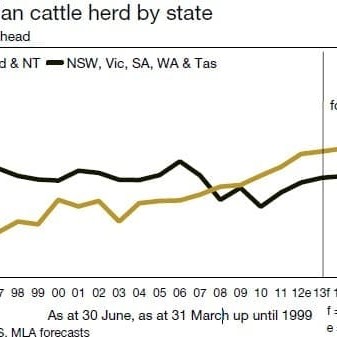 A dramatic turnaround in seasonal conditions during the second half of 2012, combined with a drier outlook for early 2013 has led to a downwards adjustment on earlier national beef herd growth forecasts in MLA’s 2013 industry projections released this morning.
A dramatic turnaround in seasonal conditions during the second half of 2012, combined with a drier outlook for early 2013 has led to a downwards adjustment on earlier national beef herd growth forecasts in MLA’s 2013 industry projections released this morning.
The seasonal impact is expected to knock about 1.5 million head off earlier growth estimates by year 2015.
With the Australian beef and dairy cattle herd estimated at 29.5 million head as at 30 June last year, up 3.5pc from a year earlier year-on-year, further expansion is expected to be cut back to 1pc in the 12-months ending June 30 this year, when the herd is expected to reach 29.8m head.
The industry projections are based on a number of key assumptions, including
- seasonal conditions in 2013 being average to below average across the majority of Australia’s cattle producing regions, with the potential for drier than average conditions during the first three months of the year for large areas of northern Australia.
- An A$ valued between US100c-110c.
MLA chief analyst Tim McRae says the national herd is now expected to plateau at 30m head by 2014 and 2015, in contrast to the previous forecast of 31.5 million head. That’s partly due to an expected increase in slaughter rates in both late 2012 and 2013, especially a higher throughput of female cattle.
“In the wake of the two wettest years on record in 2010 and 2011, along with a wet first half of 2012,
the Australia cattle producer had undertaken herd rebuilding enthusiastically, enticed by the vastly improved seasonal conditions compared to the previous drought-plagued decade, and higher cattle prices,” Mr McRae’s report says.
As at June 2012, the Australian cattle herd had increased by two million head in two years, reaching its largest national population since 1977.
Biggest growth in the north
 Not surprisingly, the majority of this expansion had been through the major cattle producing regions of northern NSW, Queensland and the NT. Indeed, by June last year, Queensland and the NT were estimated to have their largest cattle herds on record, making up 52.5pc of the national herd.
Not surprisingly, the majority of this expansion had been through the major cattle producing regions of northern NSW, Queensland and the NT. Indeed, by June last year, Queensland and the NT were estimated to have their largest cattle herds on record, making up 52.5pc of the national herd.
This figure compares with 44pc in 1977, the last time the national herd was as large as it currently is.
The expansion of the herd in northern Australia over the following 35 years has been due to several factors, most notably more reliable seasonal conditions, access to processing and lotfeeding facilities and exposure to both the live export and slaughter markets.
Allied with this was a lack of competition in many regions from other farming options, such as crops and sheep in the southern states.
The 2013 revision in the rate of the increase and absolute size of the national herd was due to a number of factors, most notably the reduced potential for the run of very wet years to continue into 2013 and beyond, Mr McRae said.
“Almost all of the early 2013 forecasts point to a drier year this year, with average maximum temperatures again set to challenge record levels. Indeed, the very dry finish to 2012, the current uncertain seasonal outlook with a late start to the northern wet season, and decreased market
returns has very quickly created a headwind for many producers to be able to sustain or, indeed, want to sustain rebuilding efforts,” he said.
Adding to the argument in favour of a plateauing in the national herd is the mounting financial costs and debt constraints faced by many cattle enterprises, especially those in northern Australia. Anecdotal evidence suggests that the requirement for cash flow and attempts to reduced debt levels will crimp the ability of producers to maintain the increase in their cattle herds – especially after two years of rebuilding, MLA suggests.
Both 2010 and 2011 delivered a period of lower operating costs, with reduced cattle sales offset by the higher cattle prices achieved, underpinning the expansion in the national herd.
However, with the drier outlook for 2013, existing higher cattle numbers (which itself will drive slaughter higher) and the ever-present need to finance debt and produce cash-flow, the emphasis for many producers is expected to shift towards consolidating breeding herds and identifying selling opportunities into the season ahead.
“At this point, it appears as though seasonal conditions and feed constraints will be the major factor influencing the slowing of the herd growth, although with financial considerations not far behind,” Mr McRae said.
- More reports on MLA’s 2013 Industry Projections on Beef Central later today, and included in tomorrow morning’s email alert to subscribers.



HAVE YOUR SAY